Isolation and Functional Characterization of a Green-Tissue Promoter in Japonica Rice (Oryza sativa subsp. Japonica)
Abstract
Simple Summary
Abstract
1. Introduction
2. Materials and Methods
2.1. Experimental Materials
2.2. Expression Analysis of Candidate Genes in Rice Organs
2.3. Promoter Cloning and Cis-Acting Element Analysis
2.4. Construction of Plant Expression Vector
2.5. Analysis of Genetic Transmission and Transgenic Detection
2.6. GUS Histochemical Staining
3. Results
3.1. The Expression Pattern Analysis of Candidate Gene Os8GSX7 in Rice
3.2. Isolation and Cloning of the Full-Length Promoter GSX7R and Its Deletion Fragment
3.3. Bioinformatics Analysis of Reverse Promoter GSX7R Sequence
3.4. Molecular Detection of Transgenic Rice
3.5. GUS Activity Analysis of GSX7R and Truncated Promoter
3.6. Evaluation of the Ability of GSX7R Promoter to Drive Foreign Genes
4. Discussion
5. Conclusions
Supplementary Materials
Author Contributions
Funding
Institutional Review Board Statement
Informed Consent Statement
Data Availability Statement
Conflicts of Interest
References
- Xue, M.; Long, Y.; Zhao, Z.; Huang, G.; Huang, K.; Zhang, T.; Jiang, Y.; Yuan, Q.; Pei, X. Isolation and Characterization of a Green-Tissue Promoter from Common Wild Rice (Oryza rufipogon Griff.). Int. J. Mol. Sci. 2018, 19, 2009. [Google Scholar] [CrossRef] [PubMed]
- Kishi-Kaboshi, M.; Aida, R.; Sasaki, K. Parsley ubiquitin promoter displays higher activity than the CaMV 35S promoter and the chrysanthemum actin 2 promoter for productive, constitutive, and durable expression of a transgene in Chrysanthemum morifolium. Breed. Sci. 2019, 69, 19036. [Google Scholar] [CrossRef] [PubMed]
- Yang, G.; Lee, Y.-H.; Jiang, Y.; Shi, X.; Kertbundit, S.; Hall, T.C. A Two-Edged Role for the Transposable Element Kiddo in the rice ubiquitin2 Promoter. Plant Cell 2005, 17, 1559–1568. [Google Scholar] [CrossRef] [PubMed]
- He, C.; Lin, Z.; McElroy, D.; Wu, R. Identification of a rice Actin 2 gene regulatory region for high-level expression of transgenes in monocots. Plant Biotechnol. J. 2009, 7, 227–239. [Google Scholar] [CrossRef] [PubMed]
- Kishi-Kaboshi, M.; Aida, R.; Sasaki, K. Generation of Gene-Edited Chrysanthemum morifolium Using Multi-Copy Transgenes as Targets and Markers. Plant. Cell Physiol. 2017, 58, 216–226. [Google Scholar] [CrossRef] [PubMed]
- Li, X.; Wang, H.-B.; Jin, H.-L. Light Signaling-Dependent Regulation of PSII Biogenesis and Functional Maintenance. Plant Physiol. 2020, 183, 1855–1868. [Google Scholar] [CrossRef]
- Jeong, H.-J.; Jung, K.-H. Rice tissue-specific promoters and condition-dependent promoters for effective translational application. J. Integr. Plant Biol. 2015, 57, 913–924. [Google Scholar] [CrossRef]
- Li, Y.; Li, C.; Cheng, L.; Yu, S.; Shen, C.; Pan, Y. Over-expression of OsPT2 under a rice root specific promoter Os03g01700. Plant Physiol. Biochem. 2019, 136, 52–57. [Google Scholar] [CrossRef]
- Oshima, M.; Taniguchi, Y.; Akasaka, M.; Abe, K.; Ichikawa, H.; Tabei, Y.; Tanaka, J. Development of a visible marker trait based on leaf sheath—Specific anthocyanin pigmentation applicable to various genotypes in rice. Breed. Sci. 2019, 69, 244–254. [Google Scholar] [CrossRef]
- Dutt, M.; Ananthakrishnan, G.; Jaromin, M.K.; Brlansky, R.H.; Grosser, J.W. Evaluation of four phloem-specific promoters in vegetative tissues of transgenic citrus plants. Tree Physiol. 2012, 32, 83–93. [Google Scholar] [CrossRef]
- Wang, M.; Yan, W.; Peng, X.; Chen, Z.; Xu, C.; Wu, J.; Deng, X.W.; Tang, X. Identification of late-stage pollen-specific promoters for construction of pollen-inactivation system in rice. J. Integr. Plant. Biol. 2020, 62, 1246–1263. [Google Scholar] [CrossRef] [PubMed]
- Kim, J.H.; Jung, I.J.; Kim, D.Y.; Fanata, W.I.; Son, B.H.; Yoo, J.Y.; Harmoko, R.; Ko, K.S.; Moon, J.C.; Jang, H.H.; et al. Proteomic identification of an embryo-specific 1Cys-Prx promoter and analysis of its activity in transgenic rice. Biochem. Biophys. Res. Commun. 2011, 408, 78–83. [Google Scholar] [CrossRef] [PubMed]
- Patti, T.; Bembi, B.; Cristin, P.; Mazzarol, F.; Secco, E.; Pappalardo, C.; Musetti, R.; Martinuzzi, M.; Versolatto, S.; Cariati, R.; et al. Endosperm-specific expression of human acid beta-glucosidase in a waxy rice. Rice 2012, 5, 34. [Google Scholar] [CrossRef] [PubMed][Green Version]
- Ye, R.; Zhou, F.; Lin, Y. Two novel positive cis-regulatory elements involved in green tissue-specific promoter activity in rice (Oryza sativa L. ssp.). Plant. Cell Rep. 2012, 31, 1159–1172. [Google Scholar] [CrossRef]
- Yang, Y.-Y.; Mei, F.; Zhang, W.; Shen, Z.; Fang, J. Creation of Bt Rice Expressing a Fusion Protein of Cry1Ac and Cry1I-Like Using a Green Tissue-Specific Promoter. J. Econ. Entomol. 2014, 107, 1674–1679. [Google Scholar] [CrossRef] [PubMed]
- Manikandan, R.; Balakrishnan, N.; Sudhakar, D.; Udayasuriyan, V. Development of leaffolder resistant transgenic rice expressing cry2AX1 gene driven by green tissue-specific rbcS promoter. World J. Microbiol. Biotechnol. 2016, 32, 37. [Google Scholar] [CrossRef]
- Bai, J.; Wang, X.; Wu, H.; Ling, F.; Zhao, Y.; Lin, Y.; Wang, R. Comprehensive construction strategy of bidirectional green tissue-specific synthetic promoters. Plant. Biotechnol. J. 2020, 18, 668–678. [Google Scholar] [CrossRef]
- Cai, M.; Yuan, T.; Duan, L.; Li, X.; Wang, S. Identification of potential protein regulators bound to the tissue-specific positive and negative cis-acting elements of a green tissue-specific promoter in rice. Plant. Biol. 2008, 10, 771–777. [Google Scholar] [CrossRef]
- Liu, W.; Mazarei, M.; Ye, R.; Peng, Y.; Shao, Y.; Baxter, H.L.; Sykes, R.W.; Turner, G.B.; Davis, M.F.; Wang, Z.-Y.; et al. Switchgrass (Panicum virgatum L.) promoters for green tissue-specific expression of the MYB4 transcription factor for reduced-recalcitrance transgenic switchgrass. Biotechnol. Biofuels 2018, 11, 122. [Google Scholar] [CrossRef]
- Matsuoka, M.; Kyozuka, J.; Shimamoto, K.; Kano-Murakami, Y. The promoters of two carboxylases in a C4 plant (maize) direct cell-specific, light-regulated expression in a C3 plant (rice). Plant J. 1994, 6, 311–319. [Google Scholar] [CrossRef]
- Cai, M.; Wei, J.; Li, X.; Xu, C.; Wang, S. A rice promoter containing both novel positive and negative cis-elements for regulation of green tissue-specific gene expression in transgenic plants. Plant Biotechnol. J. 2007, 5, 664–674. [Google Scholar] [CrossRef] [PubMed]
- Liu, S.-J.; Yue, Q.-J.; Zhang, W. Structural and functional analysis of an asymmetric bidirectional promoter in Arabidopsis thaliana. J. Integr. Plant. Biol. 2015, 57, 162–170. [Google Scholar] [CrossRef]
- Chennareddy, S.; Cicak, T.; Clark, L.; Russell, S.; Skokut, M.; Beringer, J.; Yang, X.; Jia, Y.; Gupta, M. Expression of a novel bi-directional Brassica napus promoter in soybean. Transgenic Res. 2017, 26, 727–738. [Google Scholar] [CrossRef] [PubMed]
- Mitra, A.; Han, J.; Zhang, Z.J.; Mitra, A. The intergenic region of Arabidopsis thaliana cab1 and cab2 divergent genes functions as a bidirectional promoter. Planta 2009, 229, 1015–1022. [Google Scholar] [CrossRef] [PubMed]
- Li, Z.T.; Jayasankar, S.; Gray, D.J. Bi-directional Duplex Promoters with Duplicated Enhancers Significantly Increase Transgene Expression in Grape and Tobacco. Transgenic Res. 2004, 13, 143–154. [Google Scholar] [CrossRef]
- Ladha, J.K.; Tirol-Padre, A.; Reddy, K.; Ventura, W. Prospects and Problems of Biological Nitrogen Fixation in Rice Production: A Critical Assessment; Springer: Cham, Switzerland, 1993; pp. 677–682. [Google Scholar]
- Javed, T.; Ali, M.M.; Shabbir, R.; Gull, S.; Ali, A.; Khalid, E.; Abbas, A.N.; Tariq, M. Muqmirah Rice seedling establishment as influenced by cultivars and seed priming with potassium nitrate. J. Appl. Res. Plant Sci. 2020, 1, 65–75. [Google Scholar] [CrossRef]
- Wang, R.; Yan, Y.; Zhu, M.; Yang, M.; Zhou, F.; Chen, H.; Lin, Y. Isolation and Functional Characterization of Bidirectional Promoters in Rice. Front. Plant Sci. 2016, 7, 766. [Google Scholar] [CrossRef]
- Chen, S.; Songkumarn, P.; Liu, J.; Wang, G.-L. A Versatile Zero Background T-Vector System for Gene Cloning and Functional Genomics. Plant Physiol. 2009, 150, 1111–1121. [Google Scholar] [CrossRef]
- Chen, H.; Zhao, Y.; Chong, K. Improved High-efficiency System for Rice Transformation Using Mature Embryo-derived Calli. Chinese Bull. Bot. 2008, 25, 322–331. [Google Scholar]
- Su, J.; Zhang, G.; Yu, W.; Song, H. Exogenous Cry1Ac/CpTI of Common Wild Rice by Introgressing from Transgenic Cultivated Rice can be Stable Inheritance and Expression. GMO Biosaf. Res. 2012, 2, 12–17. [Google Scholar] [CrossRef]
- Nakamura, S.; Nakao, A.; Kawamukai, M.; Kimura, T.; Ishiguro, S.; Nakagawa, T. Development of Gateway Binary Vectors, R4L1pGWBs, for Promoter Analysis in Higher Plants. Biosci. Biotechnol. Biochem. 2009, 73, 2556–2559. [Google Scholar] [CrossRef] [PubMed][Green Version]
- Dutt, M.; Dhekney, S.A.; Soriano, L.; Kandel, R.; Grosser, J.W. Temporal and spatial control of gene expression in horticultural crops. Hortic. Res. 2014, 1, 14047. [Google Scholar] [CrossRef] [PubMed]
- Brázda, V.; Bartas, M.; Bowater, R.P. Evolution of Diverse Strategies for Promoter Regulation. Trends Genet. 2021, 37, 730–744. [Google Scholar] [CrossRef] [PubMed]
- Li, D.; Xu, R.; Lv, D.; Zhang, C.; Yang, H.; Zhang, J.; Wen, J.; Li, C.; Tan, X. Identification of the Core Pollen-Specific Regulation in the Rice OsSUT3 Promoter. Int. J. Mol. Sci. 2020, 21, 1909. [Google Scholar] [CrossRef]
- Ali, M.M.; Alam, S.M.; Anwar, R.; Ali, S.; Shi, M.; Liang, D.; Lin, Z.; Chen, F. Genome-Wide Identification, Characterization and Expression Profiling of Aluminum-Activated Malate Transporters in Eriobotrya japonica Lindl. Horticulturae 2021, 7, 441. [Google Scholar] [CrossRef]
- Baum, K.; Groning, B.; Meier, I. Improved ballistic transient transformation conditions for tomato fruit allow identification of organ-specific contributions of I-box and G-box to the RBCS2 promoter activity. Plant J. 1997, 12, 463–469. [Google Scholar] [CrossRef]
- Zhi, C.; Ali, M.M.; Alam, S.M.; Gull, S.; Ali, S.; Yousef, A.F.; Ahmed, M.A.A.; Ma, S.; Chen, F. Genome-Wide in Silico Analysis and Expression Profiling of Phosphoenolpyruvate Carboxylase Genes in Loquat, Apple, Peach, Strawberry and Pear. Agronomy 2021, 12, 25. [Google Scholar] [CrossRef]
- Lopez-Ochoa, L.; Acevedo-Hernandez, G.; Martinez-Hernandez, A.; Arguello-Astorga, G.; Herrera-Estrella, L. Structural relationships between diverse cis-acting elements are critical for the functional properties of a rbcS minimal light regulatory unit. J. Exp. Bot. 2007, 58, 4397–4406. [Google Scholar] [CrossRef]
- Mao, D.; Xin, Y.; Tan, Y.; Hu, X.; Bai, J.; Liu, Z.; Yu, Y.; Li, L.; Peng, C.; Fan, T.; et al. Natural variation in the HAN1 gene confers chilling tolerance in rice and allowed adaptation to a temperate climate. Proc. Natl. Acad. Sci. USA 2019, 116, 3494–3501. [Google Scholar] [CrossRef]
- Park, M.-R.; Yun, K.-Y.; Mohanty, B.; Herath, V.; Xu, F.; Wijaya, E.; Bajic, V.B.; YUN, S.-J.; De Los Reyes, B.G. Supra-optimal expression of the cold-regulated OsMyb4 transcription factor in transgenic rice changes the complexity of transcriptional network with major effects on stress tolerance and panicle development. Plant Cell Environ. 2010, 33, 2209–2230. [Google Scholar] [CrossRef]
- Liu, X.; Yang, L.; Zhou, X.; Zhou, M.; Lu, Y.; Ma, L.; Ma, H.; Zhang, Z. Transgenic wheat expressing Thinopyrum intermedium MYB transcription factor TiMYB2R-1 shows enhanced resistance to the take-all disease. J. Exp. Bot. 2013, 64, 2243–2253. [Google Scholar] [CrossRef] [PubMed]

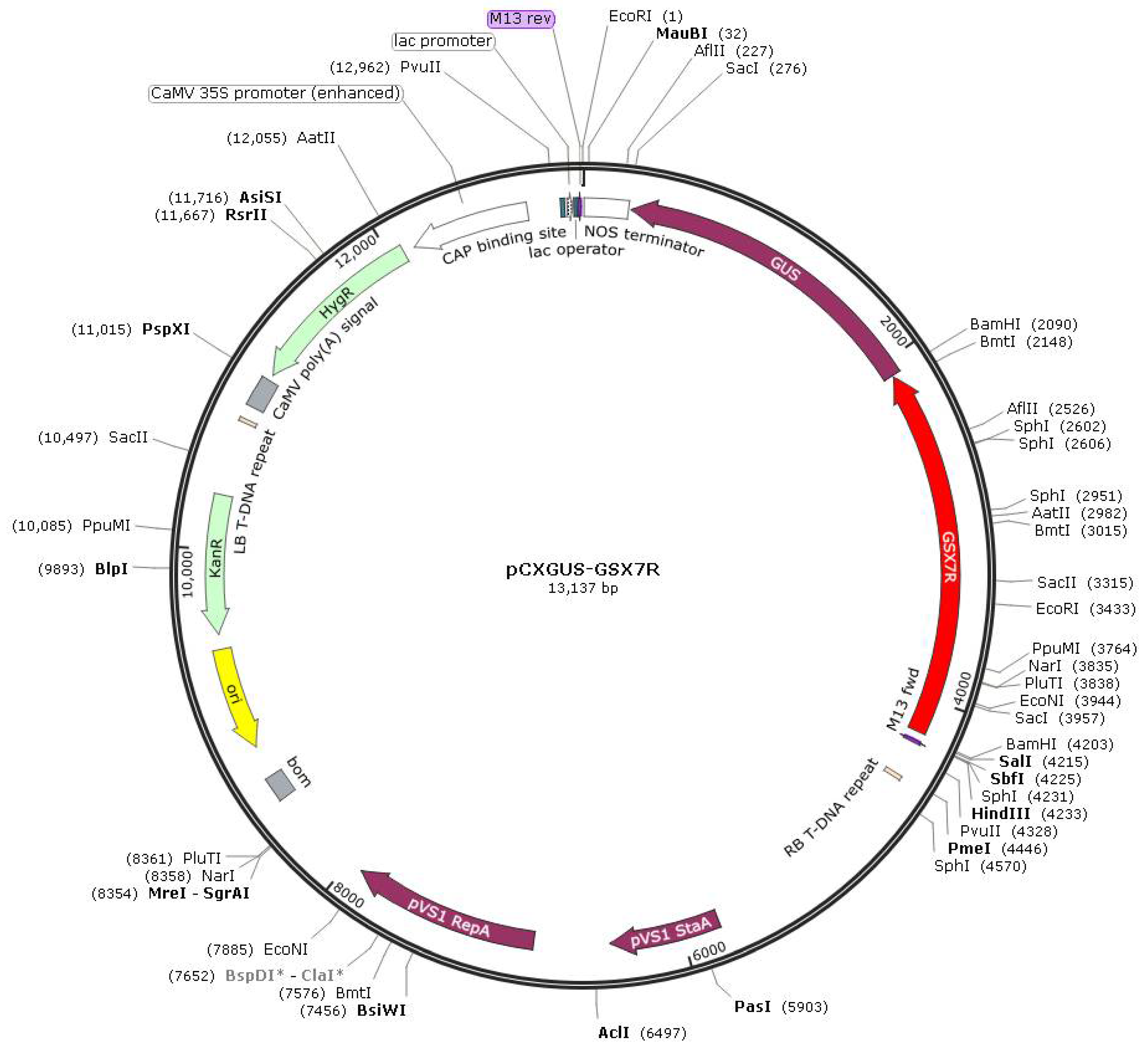
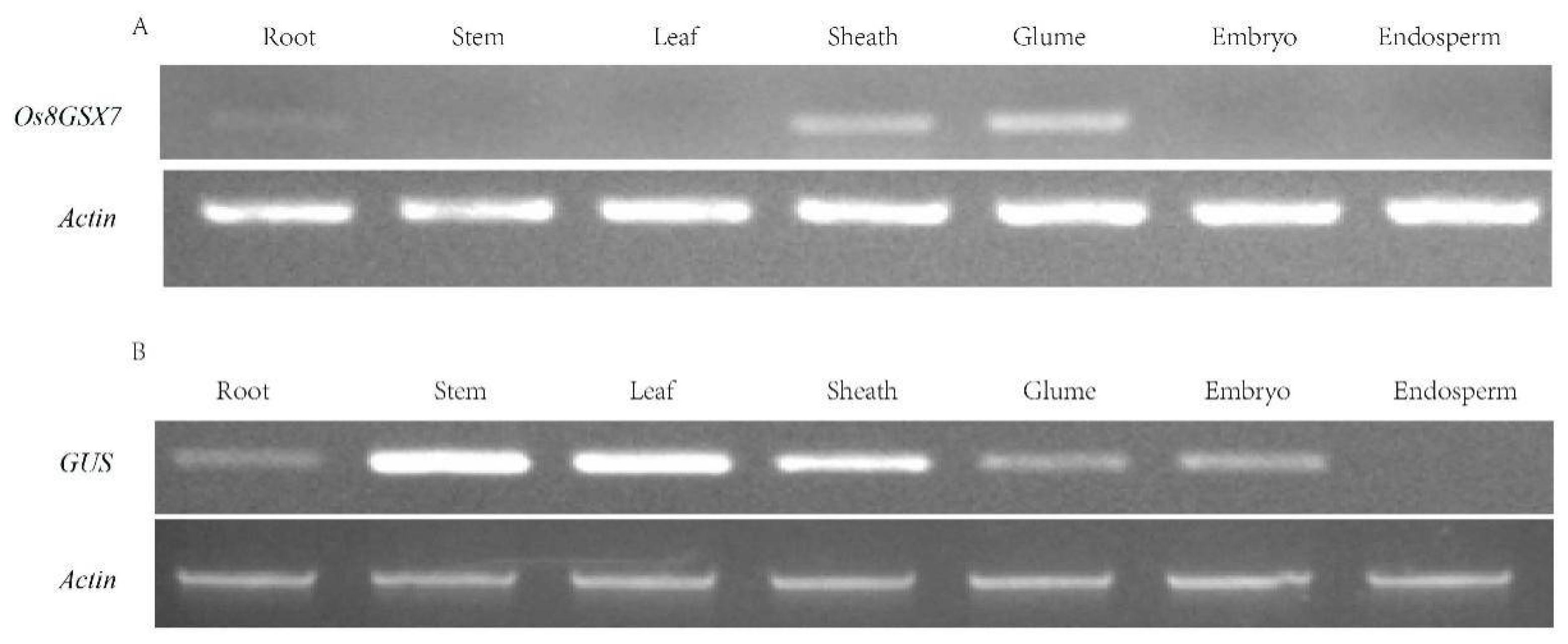
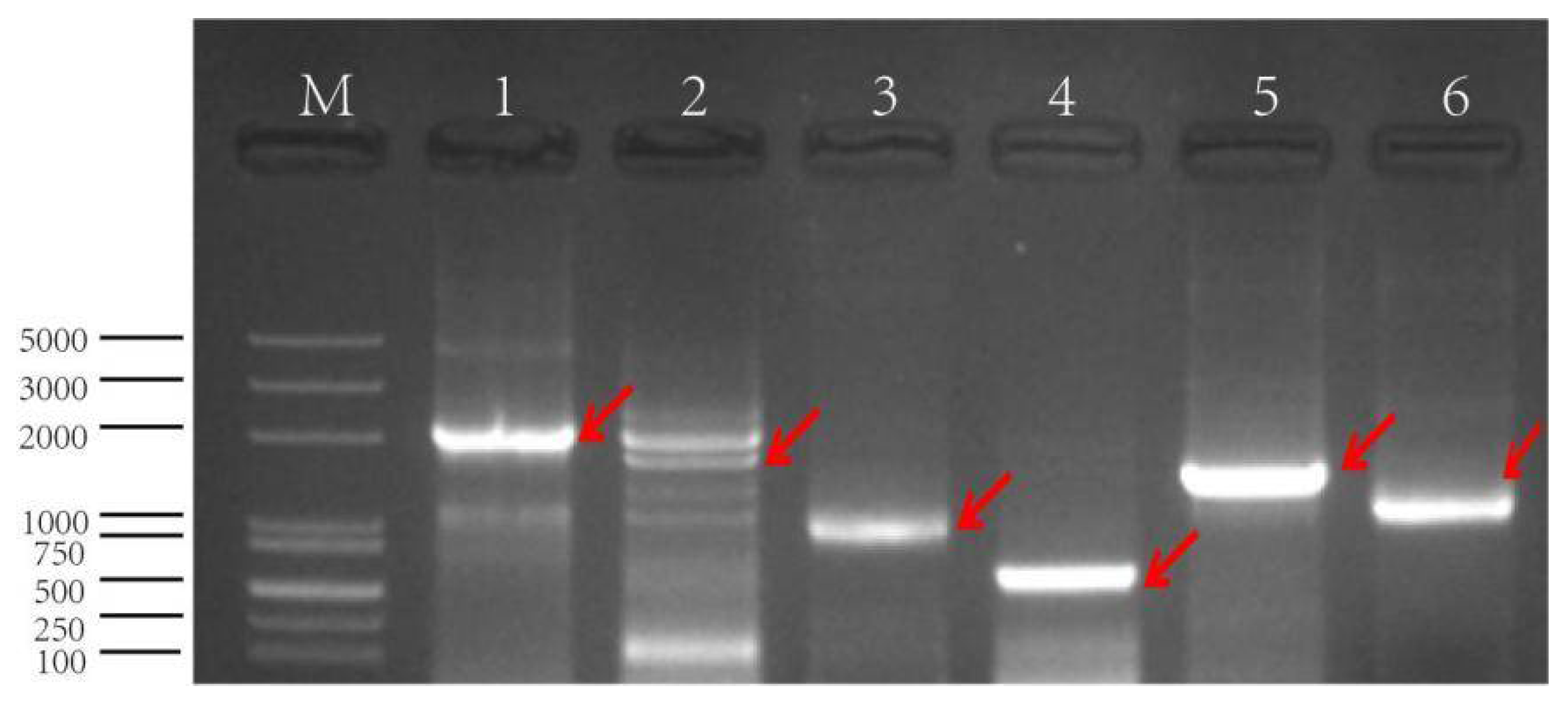
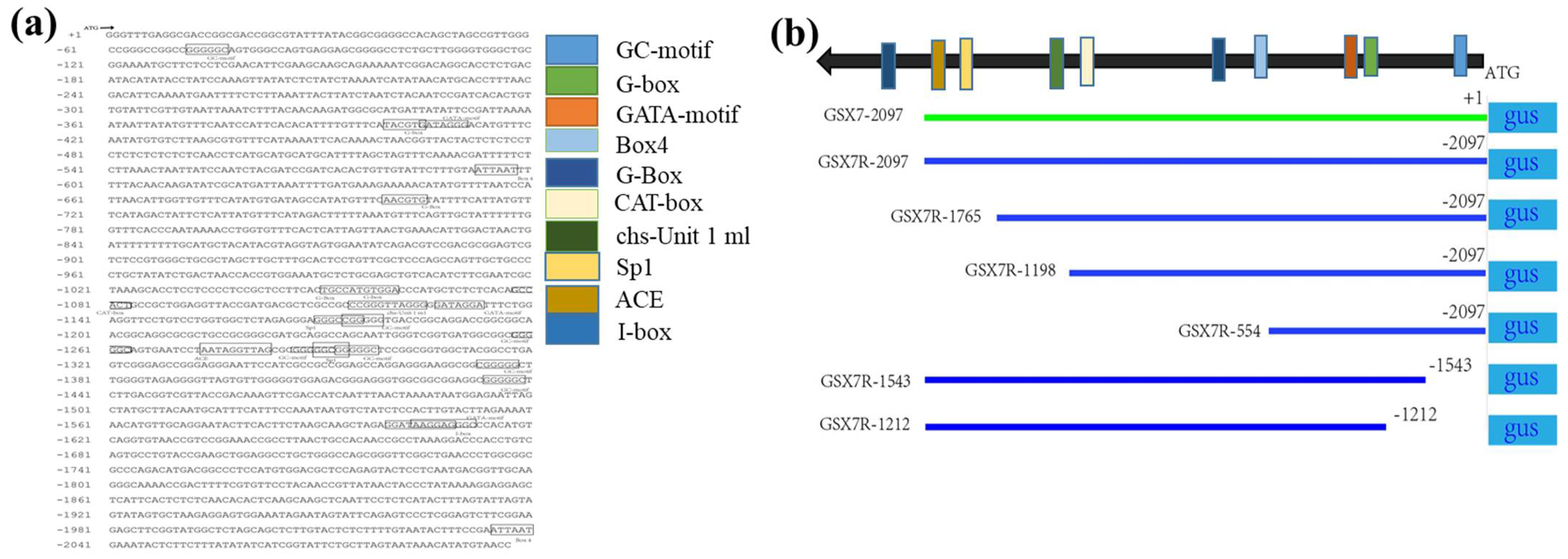

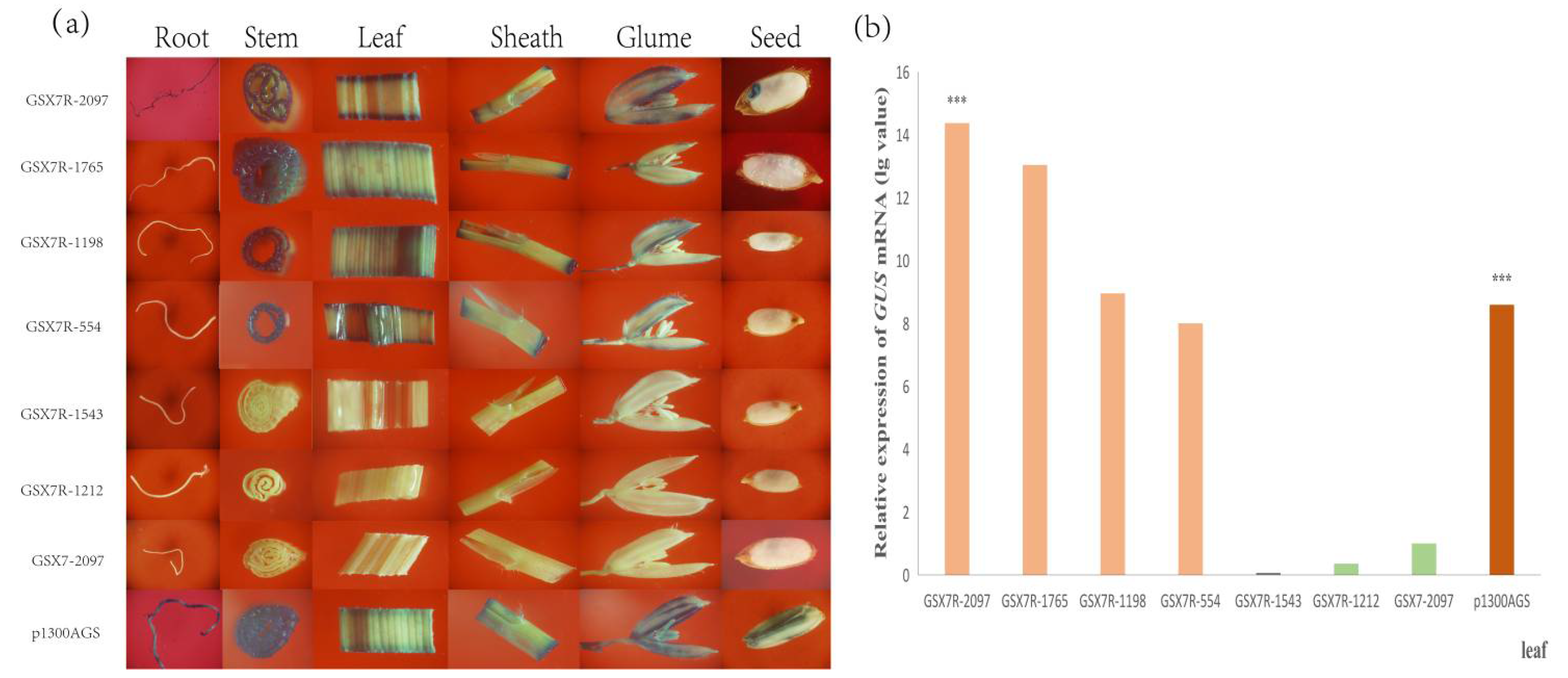
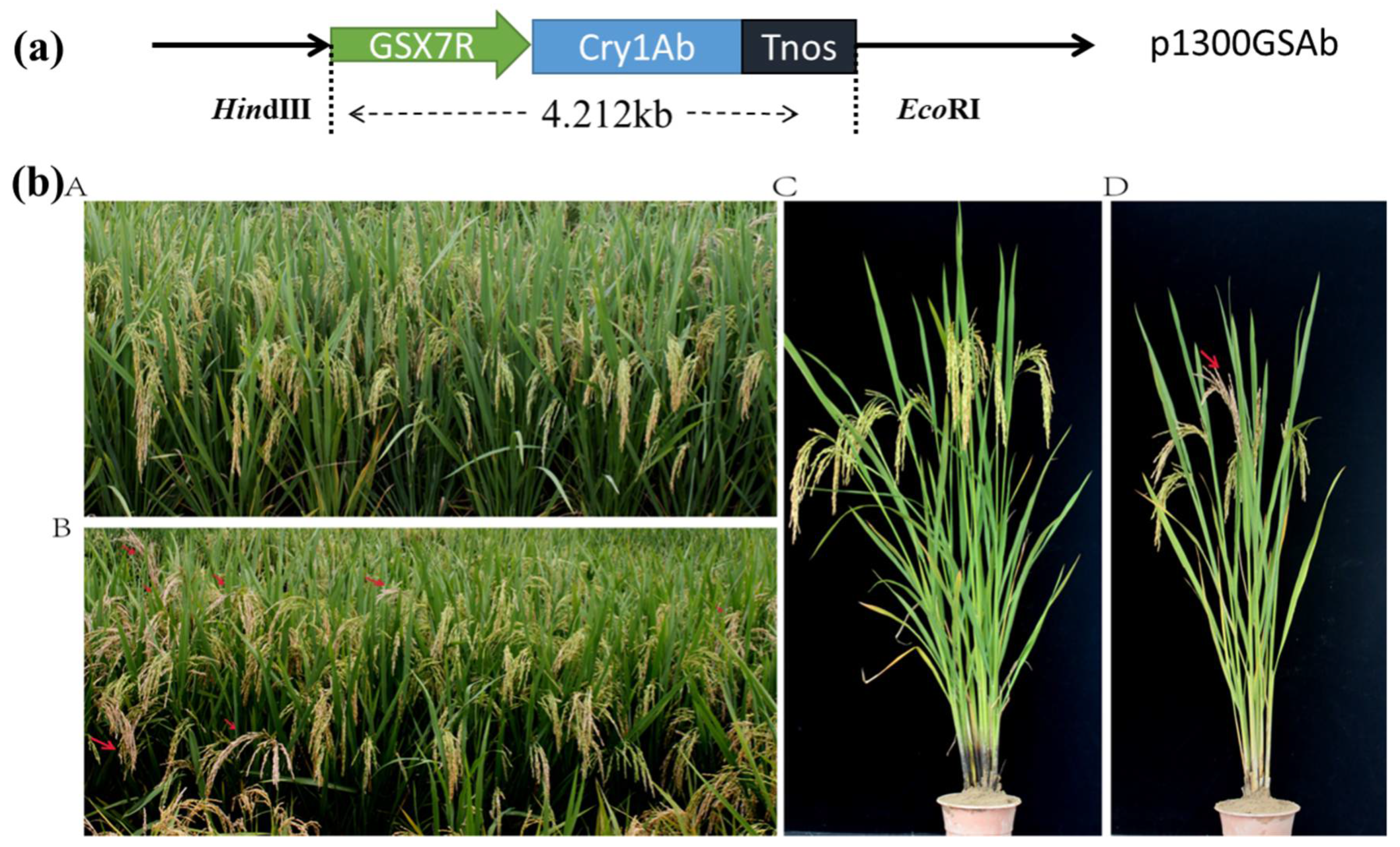
| Primer Name | Sequence(5′-3′) | Usage |
|---|---|---|
| GSX7-2097F | GGTTACATATGTTTATTACTAAGC | Full-length cloning of forward promoter |
| GSX7-2097R | GGGTTTGAGGCGACCGGCGACCGGC | |
| GSX7R-2097F | GGGTTTGAGGCGACCGGCGACCGGC | Full length cloning of reverse promoter |
| GSX7R3R | GGTTACATATGTTTATTACTAAGCA | |
| GSX7R-1765F | ATGGCGCATGATTATATTCCGATTA | 5′ deletion cloning |
| GSX7R3R | GGTTACATATGTTTATTACTAAGCA | |
| GSX7R-1198F | GTCTCCGTGGGCTGCGCTAGCTTGC | 5′ deletion cloning |
| GSX7R3R | GGTTACATATGTTTATTACTAAGCA | |
| GSX7R-554F | ACTTGTACTTAGAAAATAACATGTT | 5′ deletion cloning |
| GSX7R3R | GGTTACATATGTTTATTACTAAGCA | |
| GSX7R-2097F | GGGTTTGAGGCGACCGGCGACCGGC | 3′ deletion cloning |
| GSX7R-1543R | GGAGATAGACATTATTTGGAAATGA | |
| GSX7R-2097F | GGGTTTGAGGCGACCGGCGACCGGC | 3′ deletion cloning |
| GSX7R-1212R | CGCGCCTGCCGTTGCCGCCGGTCCT | |
| hptF | ACACAGCCATCGGTCCAGA | hpt maker gene identification |
| hptR | TAGGAGGGCGTGGATATGTC | |
| Os8GSX7F | GCTCGACGCATGCATGGCACAG | RT-PCR |
| Os8GSX7R | GTCCAATATGTGGAATCTGATC | |
| GUSF | GAACTGGCAGACTATCCCGCCGG | RT-PCR |
| GUSR | CCTGCCAGTCAACAGACGCGTGG | |
| ActinF | CATGCTATCCCTCGTCTCG | Reference gene |
| ActinR | CGCACTTCATGATGGAGTTG |
Publisher’s Note: MDPI stays neutral with regard to jurisdictional claims in published maps and institutional affiliations. |
© 2022 by the authors. Licensee MDPI, Basel, Switzerland. This article is an open access article distributed under the terms and conditions of the Creative Commons Attribution (CC BY) license (https://creativecommons.org/licenses/by/4.0/).
Share and Cite
Lin, M.; Yan, J.; Ali, M.M.; Wang, S.; Tian, S.; Chen, F.; Lin, Z. Isolation and Functional Characterization of a Green-Tissue Promoter in Japonica Rice (Oryza sativa subsp. Japonica). Biology 2022, 11, 1092. https://doi.org/10.3390/biology11081092
Lin M, Yan J, Ali MM, Wang S, Tian S, Chen F, Lin Z. Isolation and Functional Characterization of a Green-Tissue Promoter in Japonica Rice (Oryza sativa subsp. Japonica). Biology. 2022; 11(8):1092. https://doi.org/10.3390/biology11081092
Chicago/Turabian StyleLin, Mi, Jingwan Yan, Muhammad Moaaz Ali, Shaojuan Wang, Shengnan Tian, Faxing Chen, and Zhimin Lin. 2022. "Isolation and Functional Characterization of a Green-Tissue Promoter in Japonica Rice (Oryza sativa subsp. Japonica)" Biology 11, no. 8: 1092. https://doi.org/10.3390/biology11081092
APA StyleLin, M., Yan, J., Ali, M. M., Wang, S., Tian, S., Chen, F., & Lin, Z. (2022). Isolation and Functional Characterization of a Green-Tissue Promoter in Japonica Rice (Oryza sativa subsp. Japonica). Biology, 11(8), 1092. https://doi.org/10.3390/biology11081092







